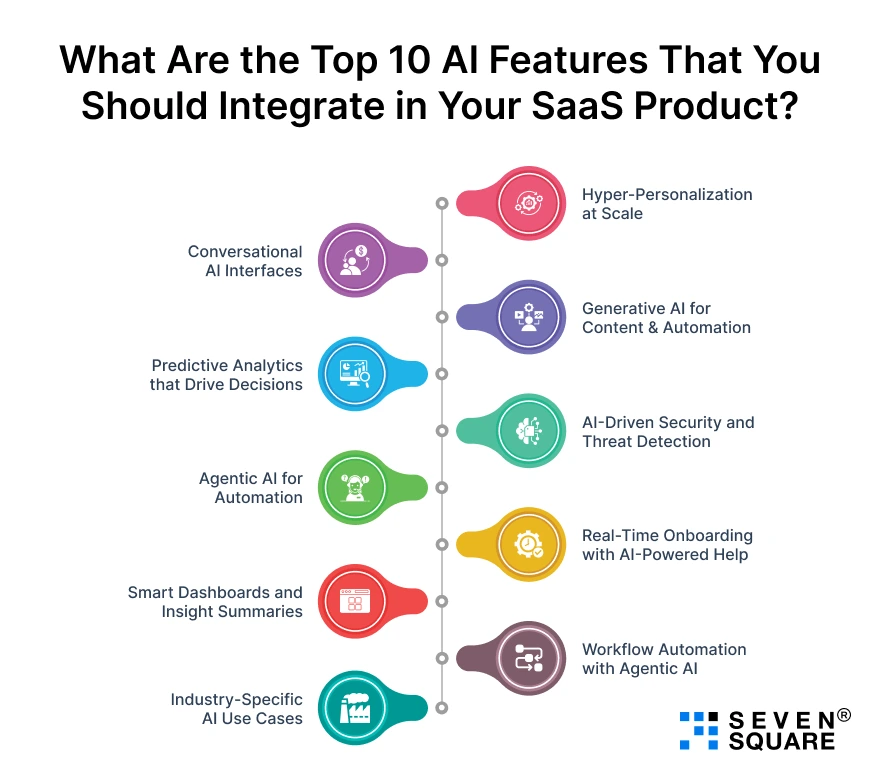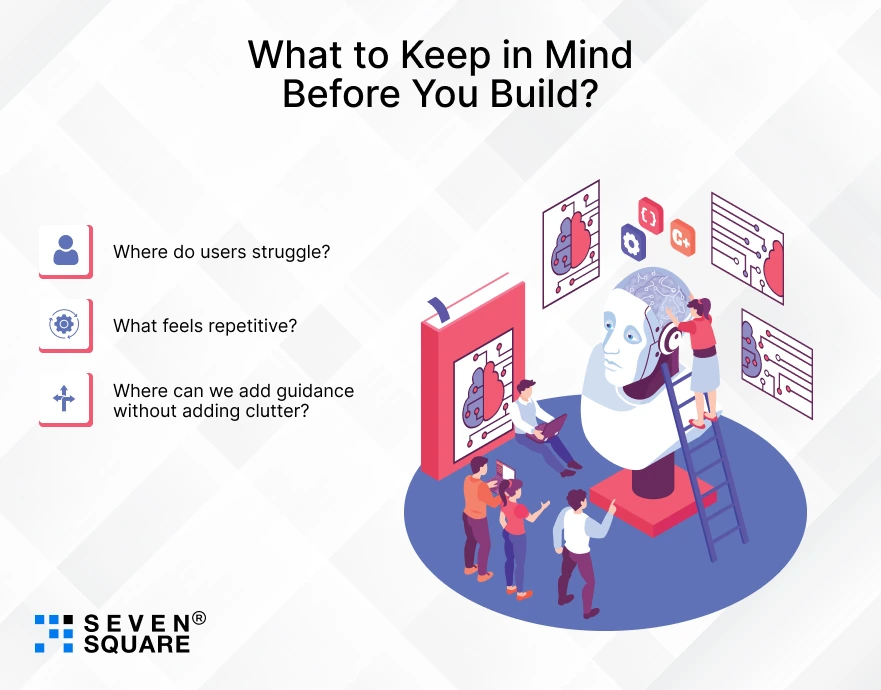You’re building a SaaS product in 2025.
You’ve nailed the UX, picked the right cloud stack, and launched your MVP.
But here’s the catch, your users expect more.
Not just a clean interface or bug-free experience, they want intelligence.
The kind that learns, adapts, and helps them do more with less effort.
The good news?
You don’t need to be OpenAI to deliver that.
The top SaaS products in 2025 are already powered by AI features in SaaS 2025 and the gap between AI-native and AI-absent apps is growing fast.
At Seven Square, we’ve helped to integrate AI into real SaaS products.
From logistics platforms using predictive analytics to education apps deploying conversational AI, we’ve seen what works and what users now demand.
In this blog you can learn about the top AI features in SaaS and what features you should integrate in SaaS products.
Explore these top AI tools for SME growth.
Why Is AI in SaaS No Longer Optional?
Think about your favorite SaaS tools.
Chances are, they already include AI under the hood whether it’s surfacing smart suggestions, summarizing your reports, or proactively alerting you to things you didn’t catch.
That’s because the modern SaaS user isn’t just looking for software, they’re looking for a co-pilot. One that saves them time, reduces clicks and gets work done faster.
For SaaS founders and product leaders, ignoring AI now means falling behind.
But integrating AI doesn’t mean hiring a team of PhDs or reinventing the wheel. It means choosing the right use cases and implementing them with focus.
What Are the Top 10 AI Features That You Should Integrate in Your SaaS Product?

Let’s explore the AI SaaS features that will define great products in 2025 and how we’ve implemented them at Seven Square.
1. Hyper-Personalization at Scale
In 2025, users expect your app to know them. Hyper-personalization isn’t just about using their first name or showing recent activity. It’s about:
- Predicting what they’ll do next
- Recommending features before they search for them
- Customizing dashboards based on behavior
Hyper-personalization in SaaS uses behavioral AI, real-time data streams, and clustering models to deliver user-specific experiences.
We implemented this for a retail SaaS platform where dashboards are updated based on buyer personas, regions, and even current stock trends.
Engagement went up by 42%.
2. Conversational AI Interfaces
Static menus are dying. In-app search is good, but what users love in 2025 is talking about their SaaS product.
Conversational AI interfaces SaaS solutions let users:
- Ask natural language questions (“Show me sales for Q3 in the US”)
- Get proactive nudges (“Do you want to reorder last month’s inventory?”)
- Navigate the app via AI chat or voice commands
We helped a healthcare SaaS app integrate a custom GPT-based bot that handled 78% of user queries.
Result? 3x faster onboarding and support.
3. Generative AI for Content & Automation
Generative AI for SaaS isn’t just ChatGPT bolted into your platform. It’s:
- Creating emails, reports, meeting summaries
- Creating user-generated content at scale
- Auto-building onboarding guides or tooltips
If your SaaS platform involves content, documentation, or any repetitive writing, this is gold.
For a legal-tech client, we built a clause generator that created 80% of document templates in under 60 seconds.
4. Agentic AI for Automation
Think of Agentic AI SaaS as AI that acts on behalf of your users. It doesn’t just suggest, it executes.
Agentic AI can:
- Trigger workflows based on user behavior
- Automate billing, CRM updates, or lead assignments
- Analyze metrics and alert users when anomalies occur
We recently used agentic models for a B2B subscription SaaS.
The AI triggered email reminders, churn-prevention workflows, and escalations cutting manual overhead by 65%.
5. Predictive Analytics that Drive Decisions
Your users don’t want raw data. They want to know what to do next.
AI in SaaS products now includes:
- Forecasting future sales
- Predicting churn
- Recommending pricing tiers
We built a forecasting engine for a logistics SaaS platform that adjusted route recommendations in real time to save fleets 12% in fuel costs.
6. AI-Driven Security and Threat Detection
Security can’t be static. In 2025, AI-driven security SaaS platforms use anomaly detection and behavioral biometrics to:
- Catch fraud before it spreads
- Detect unusual access patterns
- Automatically block or alert admins
If you’re managing sensitive user data or payments, this isn’t optional, it’s expected.
Our team built a security module for a finance SaaS that flagged fraud attempts 4 hours earlier than manual checks.
7. Real-Time Onboarding with AI-Powered Help
Onboarding is where you win or lose users. In 2025, they expect:
- AI-guided tours
- Real-time help suggestions
- Personalized checklists
We created an AI-powered onboarding features for SaaS in 2025 module that reduced first-week churn by 28%.
8. Smart Dashboards and Insight Summaries
Busy users don’t have time to dig. They want:
- Key metrics automatically surfaced
- Context-aware tips (“Why is traffic down today?”)
- Visual summaries powered by AI
How to integrate AI personalization in SaaS dashboards? Start by logging behavior, then layer it with simple LLM-driven summarizers.
For a marketing SaaS tool, we used AI to surface campaign highlights automatically no more spreadsheets or daily stand-ups.
9. Workflow Automation with Agentic AI
Users don’t want to click through 9 steps to complete a task. They want it done.
With agentic AI for automating SaaS workflows, your app becomes:
- Proactive (“Looks like you haven’t sent this invoice”)
- Autonomous (“I’ve scheduled this for you”)
- Reliable (“Here’s what I did, approve or undo”)
We deployed this for a property management SaaS that automated 65% of leasing tasks with near-zero errors.
10. Industry-Specific AI Use Cases
Every industry is different. SaaS builders need to think in terms of domain-specific AI.
Here’s what we’ve built:
- EdTech: AI tutors adapting to the learning pace
- FinTech: Fraud detection + portfolio suggestions
- HealthTech: Predictive diagnostics from form entries
- LegalTech: Generative clause + risk flagging
SaaS generative AI use cases 2025 vary, but one constant remains, custom AI that fits your user’s reality always wins.
If you decide to integrate these top AI features in your SaaS product then you can have a popular SaaS product that can scale.
What to Keep in Mind Before You Build?

You don’t need to build all ten features. In fact, please don’t.
Start with one or two high-impact AI use cases your users will use. Ask your product team:
- Where do users struggle?
- What feels repetitive?
- Where can we add guidance without adding clutter?
Then prototype fast, test honestly, and scale only what clicks.
We’ve worked with early-stage startups and global SaaS firms and what separates the winners isn’t always flashy tech. It’s a thoughtful implementation.
Focus on solving real problems.
Do you want to integrate AI features in SaaS? Contact Us Now!
Build AI with Purpose, Not Hype
Here’s the truth: in 2025, SaaS products packed with AI won’t stand out—SaaS products that solve real problems with AI will.
It’s easy to get swept up in what’s trending.
But the real winners in this new wave of AI-powered SaaS aren’t the ones chasing hype, they’re the ones focusing relentlessly on value, clarity, and execution.
At Seven Square, that’s what we do. We don’t just code features.
We work with founders to build AI that feels invisible, yet incredibly helpful.
So if you’re dreaming of a smarter, faster, more useful SaaS product, don’t wait for a trend to validate your idea.
Start with one problem. Solve it better than anyone else.
Let AI do the heavy lifting, quietly, purposefully, and always with your user at the center.
FAQs
- The most important AI features in SaaS 2025 include hyper-personalization, conversational AI, generative content tools, agentic AI for workflow automation, AI-powered dashboards, predictive analytics, and smart onboarding systems.
- These features improve user engagement, reduce churn, and drive better decisions.
- No, it’s easier than ever.
- AI-powered onboarding features for SaaS in 2025 guide users in real time, adapt based on behavior, and help reduce churn significantly.
- Yes, even early-stage SaaS startups can integrate smart features using pre-trained models, open-source tools, and APIs.
- Focus on high-impact areas like predictive analytics or generative content before scaling further.
- To integrate AI personalization in SaaS dashboards, analyze user behavior, cluster usage patterns, and use AI to surface the most relevant metrics, actions, or recommendations dynamically.